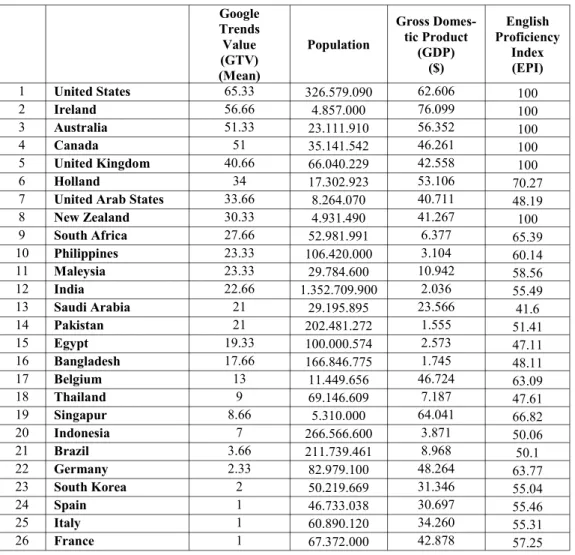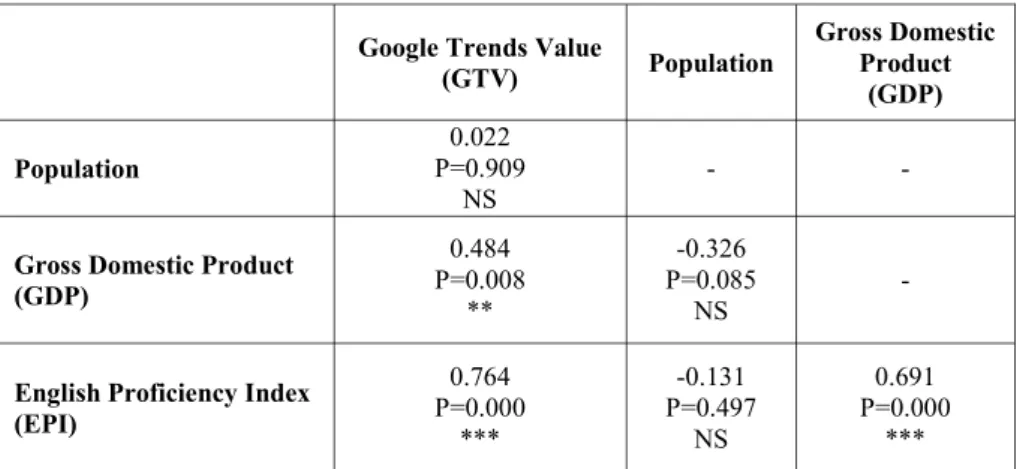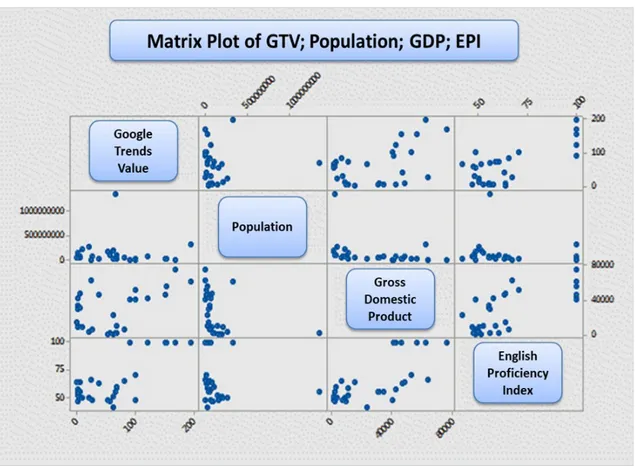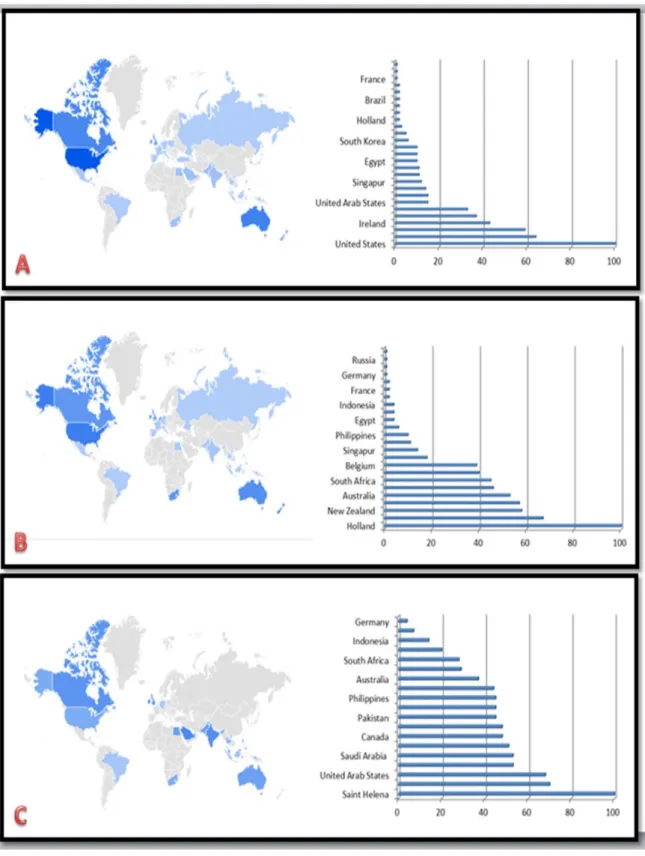OTJHS
Online Turkish Journal of Health Sciences Online Türk Sağlık Bilimleri Dergisi
OTSBD
Ortodontiye İlişkin Dünya Genelindeki İnternet Verilerinin Değerlendirilmesi: Google Trends
Analizi
Assessment of Worldwide Internet Data on the interest in Orthodontics: A Google Trends
Analysis
1Muhammed Hilmi BÜYÜKÇAVUŞ, 2Burak KALE, 3Hikmet ORHAN 1 Department of Orthodontics, Faculty of Dentistry, Suleyman Demirel University, Isparta, TURKEY
2Department of Orthodontics, Faculty of Dentistry, Antalya Bilim University, Antalya,TURKEY
3Department of Biostatistics and Medical Informatics, Faculty of Medicine, Suleyman Demirel University, Isparta, TURKEY Muhammed Hilmi Büyükçavuş: https://orcid.org/0000-0003-2184-1549
Burak Kale: https://orcid.org/0000-0001-6828-8547 Hikmet Orhan: https://orcid.org/0000-0002-8389-1069
Online Turkish Journal of Health Sciences 2020;5(4):582-590 Online Türk Sağlık Bilimleri Dergisi 2020;5(4):582-590
ÖZ
Amaç: Çalışmanın amacı, tüm dünyada Google Trends arama verilerini kullanarak son 5 yılda ortodonti konusuna olan ilgiyi incelemektir.
Materyal ve Metot: 6 Temmuz 2020’de, Google Trends uygulamasında son beş yıldaki arama verileri tarandı. Arama sonuçları, tüm anahtar kelimeler için ayrı ayrı ve yeterli veriye sahip 26 ülke için ayrı olarak kaydedildi. Tüm arama sonuçlarının ortalaması alındı ve ülkeler için bir Google Trends Değeri (GTV) elde edildi. Bu veriler nüfus, Gayri Safi Yurtiçi Hâsıla (GDP) ve ülkelerdeki İngilizce bilgisi (İngilizce Yeterlilik Endeksi – EPI) ile ilişkilendirildi. Nüfus, GDP ve EPI ile Google Trends değerleri arasındaki korelasyon değerleri için Pearson korelasyon testi kullanıldı.
Bulgular: Tabloya göre, en yüksek GTV değeri ABD'de gözlenmiştir (65,33); Fransa'da en düşük GTV değeri görülmüştür. İstatistiksel analize göre, GTV ile hem nüfus hem de GDP ile EPI değerleri arasında pozitif bir korelasyon bulundu. Son olarak GDP ve EPI değerleri arasında pozitif korelasyon bulundu ve bu pozitif korelas-yon istatistiksel olarak anlamlı bulunmuştur (p<0,05). Sonuç: Ortodontiye olan ilgi ile nüfus arasında anlamlı bir ilişki bulunamamıştır. Gayri Safi Milli Hasıla ile İngi-lizce bilgi düzeyi arasında ise anlamlı bir pozitif ilişki vardır.
Anahtar Kelimeler: Google tr ends, internet verileri, ortodonti
ABSTRACT
Objective: The aim of study is to examine the interest in orthodontics in the last 5 years using Google Trends data all over the world.
Materials and Methods: On J uly 6, 2020, the Google Trends application was searched for the last five years. Search results were recorded separately for all keywords and separately for 26 countries with sufficient data. The mean of all search results is taken and a Google Trends Value (GTV) is obtained for the countries. These data were correlated with population, Gross Domestic Product (GDP) and knowledge of English (English Proficiency Index – EPI) in countries. Pearson correlation test was used for correlation values between Population, GDP and EPI with Google Trend values.
Results: According to the table, the highest GTV were observed in United States (65.33); lowest GTV were ob-served in France. According to the statistically analysis, a positive correlation was found between GTV with both population and GDP and EPI values. Finally, a positive correlation was found between GDP and EPI values and this positive correlation was statistically significant (p<0.05).
Conclusion: No significant relationship was found be-tween the interest in orthodontics and the population. There is a significant positive correlation between the Gross National Product and the level of knowledge of English.
Keywords: Google trends, inter net data, orthodontics
Sorumlu Yazar / Corresponding Author: Muhammed Hilmi Buyukcavus
Assist. Prof. Dr, Department of Orthodontics, Faculty of Dentistry, Suleyman Demirel University, Isparta / TURKEY
Tel: +90 506 507 38 46 E-mail: mhbuyukcvs@gmail.com
Yayın Bilgisi / Article Info: Gönderi Tarihi/ Received: 28/07/2020 Kabul Tarihi/ Accepted: 30/09/2020 Online Yayın Tarihi/ Published: 30/12/2020
Atıf / Cited: Büyükçavuş MH et al. Assessment of Worldwide Internet Data on the interest in Orthodontics: A Google Trends Analysis. Online Türk Sağlık Bilimleri Dergisi 2020;5(4):582-590. doi: 10.26453/otjhs.774921
INTRODUCTION
Aesthetic treatments are becoming more and more important for the individuals of developed and deve-loping countries. In the societies that have reached a certain level of economic development, the resour-ces allocated in the aesthetic health sector increase, as well as the awareness of individuals about health.1 It can also be said that the development of health services accelerates economic development.1 There are many opinions about the high quality of life of the societies, the access of health services to the wider society, the participation of the labor force and the increase in the quality of health positively affect economic growth.1
There is a close relationship between orthodontic treatment and the level of economic and social deve-lopment in society.2 Investments in health services that increase the future dental health level of the society bring a more successful and healthy popula-tion structure which affect on patients perceppopula-tion of apperance.3 One of the treatments applied for aesthe-tic and beauty purposes that deals with the appearan-ce of people and the solution of an existing visual problem is orthodontic treatments.
Orthodontic treatment is an important part of oral health in modern life and improves oral health and quality of life by providing aesthetic, psychological functional benefits.4 The recent increase of ortho-dontic treatment with aesthetic needs in developing countries with socio-economic development has become more popular and a common clinical proce-dure.5 Orthodontic treatment prevelance ranges from 10-35% in developed countries surveys.6,7 Therefo-re, national wide surveys have helped us understan-ding the changing trends on orthodontic treatment needs.8-10
In addition to surveys on the orthodontic changing trends with socioeconomic status, internet is a very important sources of health information.11,12 Many people seek health information from internet sour-ces. The internet is used by millions of people that has become a critical role for information globally.13 The most common keyword driven search engine on internet is Google, provides Google Trends (GT) service that is able to analyze internet search in examining population behaviour since 2014.14,15 Online search query data with Google Trends could help to assess precursors of behaviour changes dist-ribution.16 Although few studies have specifically evaluated the efficacy of social media on orthodontic treatment and marketing knowledge, hasn't been
studied with the use of Google Trends data on chan-ges internet searches globally over years.17-19 The aim of study is to examine the interest in ortho-dontics in the last 5 years using Google Trends data all over the world.
MATERIALS AND METHODS
Although the data to be used for the research is ac-cessible to everyone, ethics committee permission was obtained. Our study approved by the local ethics committee of Antalya Education and Research Hos-pital (Date:03/07/2020, decision no: 203).
Google Trends is an online search tool that analyzes a specific search term entered into Google's search engine by total search volume. The interest over time is represented by numbers on the graph that reflect how many searches have been carried out for a search term, relative to the total number of searc-hes done on Google over time. To explain further, those numbers do not represent the absolute search volume, because they are normalised data and pre-sented on a scale from 0–100 in order to reduce data redundancy and improve data integrity. Each point on the graph is divided by the highest point and mul-tiplied by 100. When there is not enough data, 0 (normalised data) is shown. In regard to regional interest, the numbers represent the search volume relative to the highest point on the map, which is always 100 (normalised data).
On July 6, 2020, the Google Trends application was searched on Google for the last five years (06.07.2015-06.07.2020). Search results were recor-ded separately for all keywords and separately for 26 countries with sufficient data. The distribution of the countries with sufficient popularity data for the keywords “Orthodontics”, “Orthodontic Treatment” and “Orthodontist’’ is shown in Figure 1-3. Search terms have been made separately for other languages that are most spoken in the world. Although Chine-se, Spanish, Hindi and Turkish were also searched, Google Trends did not have enough data, as these languages were limited to specific regions. That's why only English was preferred for keywords. Countries that do not have sufficient data and do not include Google Trends were excluded. The mean of all search results is taken and a Google Trends Value (GTV) is obtained for the countries. These data are correlated with population, Gross Domestic Product (GDP) and knowledge of English in countries. Popu-lation numbers of countries are taken from Wikiland
website.On the other hand, the Gross Domestic Pro-duct (GDP) is regulated in dollars according to the data announced by the International Monetary Fund (IMF) for 2018. The level of knowledge of English is based on the most recent 2019 data of the annual EPI (English Proficiency Index) data.The EPI is an index for non-native English speakers. EPI of count-ries such as USA, Ireland, Australia, Canada, UK and New Zealand whose native language is English are accepted as 100.
Pearson correlation test was used in Minitab Statisti-cal Program for correlation values between Popula-tion, Gross Domestic Product and English Profici-ency Index with Google Trend values. In addition, in the Minitab Statistics Program, the point distribution chart of Google Trend data according to Population, Gross Domestic Product and English Proficiency Index was also prepared (Figure 1).
RESULTS
The highest GTV were found in United States (100), Australia (64), and Canada (59) when Google Trends searched for "orthodontics." The graph of all GTV and their distribution on the map is shown in
Figure 2 (A). When the term "orthodontist" was se-arched for Google Trends, the highest GTV were found in Holland (100), United States (64) and New Zealand (58). The graph of all GTV and their distri-bution on the map is shown in Figure 2 (B). The highest GTV were found in Saint Helena (100), Ire-land (70) and United Arab States (68) when Google Trends searched for "orthodontic treatment". The distribution of all GTV and their distribution on the map is shown in Figure 2 (C). The average of the GTV obtained for the three search terms and the population, GDP and EPI values of the 26 countries are shown in Table 1. According to the table, the highest GTV were observed in United States (65.33), Ireland (56.66), Australia (51.33), Canada (51) and United Kingdom (40.66); lowest GTV were observed in Germany (2.33), South Korea (2), Spain (1), Italy (1), France (1).
The correlation values between population, GDP and EPI and GTV are shown in Table 2. According to the table, a positive correlation was found between GTV with both population and GDP and EPI values. However, while the positive correlation between GTV and population was not statistically significant (p>0.05), the positive correlation between GTV and GDP and EPI values was statisti-cally significant (p<0.05). A negative correlation was found between population and GDP and EPI
values, although it was not statistically significant (p<0.05). Finally, a positive correlation was found between GDP and EPI values and this positive cor-relation was statistically significant (p<0.05).
DISCUSSION AND CONCLUSION
Orthodontics is a branch of dentistry aiming to cor-rect the crowding of teeth, malocclusion of maxil-lary and mandibular teeth and facial skeletal disor-ders.20 Orthodontics also helps to preserve oral he-alth by treating these problems.20,21 Crowding teeth aesthetically affect the facial appearance of people. Malpose and crowding teeth pose a risk of dental calculus formation and tooth caries due to difficulty in cleaning. For these reasons, orthodontic problems affect health not only for aesthetic purposes.19,20 With the aesthetic (lingual orthodontics, clear alig-ners etc.) orthodontic applications that will become more widespread and cheaper in the near future, the interest in orthodontic treatment is increasing.19-23 Day after day, more brackets have been seen in adults rather than children.24 Long treatment times and non-aesthetic appearance of brackets, which are considered as the most important disadvantage of orthodontic treatments, are no longer a problem thanks to technological advances in health.25 Invisib-le brackets (aligner treatments),26 lingual brackets27 and transparent (porcelain-sapphire) brackets,26 which have become widespread in recent years, ma-ke the adult person prefer orthodontic treatments. Orthodontic treatment can be performed at any age without aesthetic concern. These treatments, which have reached much more favorable costs than befo-re, do not force the budgets of the patients.27,28 In addition, it is possible to achieve a more natural smile with short-term orthodontic treatments made before aesthetic corrections such as implant or lami-na teeth which are very popular applications in den-tistry. The teeth that should be in their ideal place for a beautiful smile design may be mis-positioned in the jaw due to early tooth loss. Unfortunately, an aesthetic prosthesis is not possible. However, if the prosthesis is corrected by orthodontic treatment be-fore, then a beautiful smile aesthetic can be provided with lamina or zirconium. In cases with maxillary and mandibular retrognathism or prognathism, con-genital or subsequent trauma with deformity of maxilla or mandible, corrections to be made by plas-tic surgery are now performed without orthodonplas-tic treatment.
Internet is the main source of information for pati-ents in the 21st century, especially health.
Orthodon-tic treatments, treatment prices, doctors' advice on many issues, such as patients search the Internet. The interest in orthodontic treatments is increasing day by day. An increasing number of internet users search information on internet search engines every day. Google trends has been used monitoring indi-viduals behavior interests and provided search vol-ume data.29 This study aimed searching Google
Trends about Orthodontics from 2014 to 2019 using the online search query internet data for behavior changes distribution at all over the world.
Internet use and prevelance are affected by the coun-try's income level, development and health status. Mishra and Newhouse find that increased access to information on the Internet will likely have positive effects on health outcomes.30 Our results show that
interest in orthodontics via internet is considerable and consistent. As expected, there is a close relation-ship between orthodontic treatment and economic and social development level in societies. The high-est searching values regarding Orthodontics have been reached in higher economic development coun-tries.
In our findings, it is expected that the GTV in devel-oped countries with very high GDP are also ex-pected to be high. The reason for this situation is that preventive treatments are covered by health systems, especially in developed countries such as Europe countries, and the problems that may occur if the patient does not comply with regular controls and preventive treatments are out of the scope of health insurance. Therefore, orthodontic treatments are particularly expensive. Therefore, interest in orthodontics may have been found less in patients' internet searches.
As the income level of the people increases and the level of education increases, they pay more attention to their external appearance. Studies have shown that the most attention to the teeth of people at the first sight. Therefore, oral care and thus orthodontics are affected by factors such as income level and edu-cation level.
As a conclusion, we think that Google Trends alone is not enough to evaluate the interest in orthodontics. We can say that there is a high interest in orthodon-tics in internet data in countries with a high level of knowledge of English. However, no significant dif-ference was found between the number and income level of the population and interest in orthodontics.
Ethics Committee Approval: Our study approved by
the local ethics committee of Antalya Education and
Research Hospital (Date: 03/07/2020, decision no: 203).
Conflict of Interest: No conflict of interest was
dec-lared by the authors.
Author Contributions: Concept- MHB; Supervision
- MHB, BK; Materials- MHB, BK, HO; Data Col-lection and/or Processing- MHB, BK, HO; Analysis and/ or Interpretation- HO; Writing- MHB, BK.
Peer-review: Externally peer-reviewed.
REFERENCES
1. Tamer G. Demographic characteristics affecting service demand in private health ınstitutions; aesthetic medical centers example. Int J Entrepr Manag Inquir (EMI). 2018;2(3):91-105.
2. Germa A, Kaminski M, Nabet C. Impact of so-cial and economic characteristics on orthodontic treatment among children and teenagers in France. Community Dent Oral Epidemiol. 2010;38(2):171–179.
3. Van Wezel NA, Bos A, Prahl C. Expectations of treatment and satisfaction with dentofacial ap-pearance in patients applying for orthodontic treatment. Am J Orthod Dentofacial Orthop. 2015;147(6):698-703.
4. Bresnahan BW, Kiyak HA, Masters SH, McGorray SP, Lincoln A, King G. Quality of life and economic burdens of malocclusion in U.S. patients enrolled in Medicaid. J Am Dent Assoc. 2010;141(10):1202-1212.
5. Kim Y. Study on the perception of orthodontic treatment according to age: A questionnaire sur-vey. Korean J Orthod. 2017;47:215-221. 6. Proffit WR, Fields HW Jr, Moray LJ. Prevalence
of malocclusion and orthodontic treatment need in the United States: estimates from the NHANES IIIsurvey. Int J Adult Orthodon Or-thognath Surg. 1998;13:97-106.
7. Chestnutt IG, Burden DJ, Steele JG, Pitts NB, Nuttall NM, Morris AJ. The orthodontic condi-tion of children in the United Kingdom, 2003. Br Dent J. 2006;200:609-612.
8. Kamak H, Çağlaroğlu M, Çatalbaş B, Keklik H. İç anadolu bölgesi ortodontik tedavi ihtiyacının ICON indeksi kullanılarak değerlendirilmesi. Atatürk Üniv Diş Hek Fak Derg. 2012;22:149-153.
9. Kılıçoğlu H, Arman S, Par C, Çifter M, Akar B. İstanbul Üniversitesi ortodonti anabilim dalına başvuran hastaların profilinin incelenmesi. Türk Ortodonti Derg. 2003;16:167-174.
10. Ugur T, Ciger S, Aksoy A, Telli A. An epidemi-ological survey using the Treatment Priority In-dex (TPI). Eur J Orthod. 1998;20:189-193. 11. Noll D. Mahon B. Shroff B. Carrico C. Lindauer
SJ. Twitter analysis of the orthodontic patient experience with braces vs Invisalign. Angle Or-thod. 2017;87:377-383.
12. Al Ghamdi KM. Moussa NA. Internet use by the public to search for health-related infor-mation. Int J Med Inform. 2012;81:363-373. 13. Allem JP, Leas EC, Caputi TL, et al. The Charlie
Sheen effect on rapid in-home human immuno-deficiency virus test sales. Prev Sci. 2017;18 (5):541-544
14. Ayers JW, Althouse BM, Johnson M, Cohen JE. Circaseptan (weekly) rhythms in smoking cessa-tion consideracessa-tions. JAMA Intern Med. 2014;174:146–148.
15. Zotti F, Zotti R, Albanese M, Nocini PF, Pa-ganelli C. Implementing post-orthodontic com-pliance among adolescents wearing removable retainers through Whatsapp: a pilot study. Patient Prefer Adherence. 2019;13:609-615.
16. Papadimitriou A, Kakali L, Pazera P, Doulis I, Kloukos D. Social media and orthodontic treat-ment from the patient's perspective: a systematic review. Eur J Orthod. 2019;pii: cjz029. doi: 10.1093/ejo/cjz029.
17. Lena Y, Dindaroğlu F. Lingual orthodontic treat-ment: A YouTube™ video analysis. Angle Or-thod. 2018;88(2):208-214.
18. Noll D, Mahon B, Shroff B, Carrico C, Lindauer SJ. Twitter analysis of the orthodontic patient experience with braces vs Invisalign. Angle Or-thod. 2017;87(3):377-383.
19. Chan A, Antoun JS, Morgaine KC, Farella M. Accounts of bullying on Twitter in relation to dentofacial features and orthodontic treatment. J Oral Rehabil. 2017;44(4):244-250.
20. DiBiase AT, Sandler PJ. Malocclusion, ortho-dontics and bullying. Dental update. 2001;28 (9):464-466.
21. Kuo E, Miller RJ. Automated custom-manufacturing technology in orthodontics. Am J Orthod Dentofacial Orthop. 2003;123(5):578-581.
22. Melkos AB. Advances in digital technology and orthodontics: a reference to the Invisalign meth-od. Med Sci Monit. 2005;11(5):39-42.
23. McCrostie HS. Lingual orthodontics: the future. Semin Orthod. 2006;12(3):211-214.
24. Almuzian M, Gardner A. Adult orthodontics part 1: special considerations in treat-ment. Orthodontic Update. 2014;7(3):89-92. 25. McDonald F, Cobourne M. Adult orthodontics:
perils and pitfalls. Prog Orthod. 2007;8(2):308-313.
26. Malik OH, McMullin A, Waring DT. Invisible orthodontics part 1: Invisalign. Dental up-date. 2013;40(3):203-215.
27. Panula K, Keski-Nisula L, Keski-Nisula K, Oi-karinen K, Keski-Nisula S. Costs of surgical-orthodontic treatment in community hospital care: an analysis of the different phases of treat-ment. Int J Orthod Orthognath Surg. 2002;17 (4):297-306.
28. Richmond S, Phillips CJ, Dunstan F, Daniels C, Durning P, Leahy F. Evaluating the cost-effectiveness of orthodontic provision. Dental Update. 2004;31(3):146-152.
29. Mondria J, Wu T. Imperfect financial integration and asymmetric information: competing explana-tions of the home bias puzzle? Canadian Journal of Economics. 2013;46:310-337.
30. Mishra P, Newhouse D. “Does health aid mat-ter ?” Journal of Health Economics, Corrected Proof. 2009;28(4):855-872.
Table 1. Google Tr ends values, population, Gr oss Domestic Pr oduct and English Pr oficiency Index of countries in worldwide. Google Trends Value (GTV) (Mean) Population Gross Domes-tic Product (GDP) ($) English Proficiency Index (EPI) 1 United States 65.33 326.579.090 62.606 100 2 Ireland 56.66 4.857.000 76.099 100 3 Australia 51.33 23.111.910 56.352 100 4 Canada 51 35.141.542 46.261 100 5 United Kingdom 40.66 66.040.229 42.558 100 6 Holland 34 17.302.923 53.106 70.27
7 United Arab States 33.66 8.264.070 40.711 48.19
8 New Zealand 30.33 4.931.490 41.267 100 9 South Africa 27.66 52.981.991 6.377 65.39 10 Philippines 23.33 106.420.000 3.104 60.14 11 Maleysia 23.33 29.784.600 10.942 58.56 12 India 22.66 1.352.709.900 2.036 55.49 13 Saudi Arabia 21 29.195.895 23.566 41.6 14 Pakistan 21 202.481.272 1.555 51.41 15 Egypt 19.33 100.000.574 2.573 47.11 16 Bangladesh 17.66 166.846.775 1.745 48.11 17 Belgium 13 11.449.656 46.724 63.09 18 Thailand 9 69.146.609 7.187 47.61 19 Singapur 8.66 5.310.000 64.041 66.82 20 Indonesia 7 266.566.600 3.871 50.06 21 Brazil 3.66 211.739.461 8.968 50.1 22 Germany 2.33 82.979.100 48.264 63.77 23 South Korea 2 50.219.669 31.346 55.04 24 Spain 1 46.733.038 30.697 55.46 25 Italy 1 60.890.120 34.260 55.31 26 France 1 67.372.000 42.878 57.25
Table 2. Cor r elation values of population, Gross Domestic Product and English Proficiency Index
with Google Trends values.
Google Trends Value
(GTV) Population Gross Domestic Product (GDP) Population 0.022 P=0.909 NS - -
Gross Domestic Product (GDP) 0.484 P=0.008 ** -0.326 P=0.085 NS -
English Proficiency Index (EPI) 0.764 P=0.000 *** -0.131 P=0.497 NS 0.691 P=0.000 ***
P:Pearson correlation test; Low (± 0.01 <r <± 0.5); Moderate (± 0.5 <r <± 0.5); High Correlation (± 0.8 <r <± 1); *p<0.05; **p<0.01; ***p<0.001; p>0.05: NS (not significant).
Figure 1. The distr ibution gr aphics of Google Tr ends values with population, Gr oss Domestic Pr o-duct and English Proficiency Index.
Figure 2. Distr ibutions of sear ch r esults of the ter m ‘’Or thodontics’’(A), ‘’Orthodontists’’(B) and ‘’Orthodontic Treatment’’(C) in worldwide.



